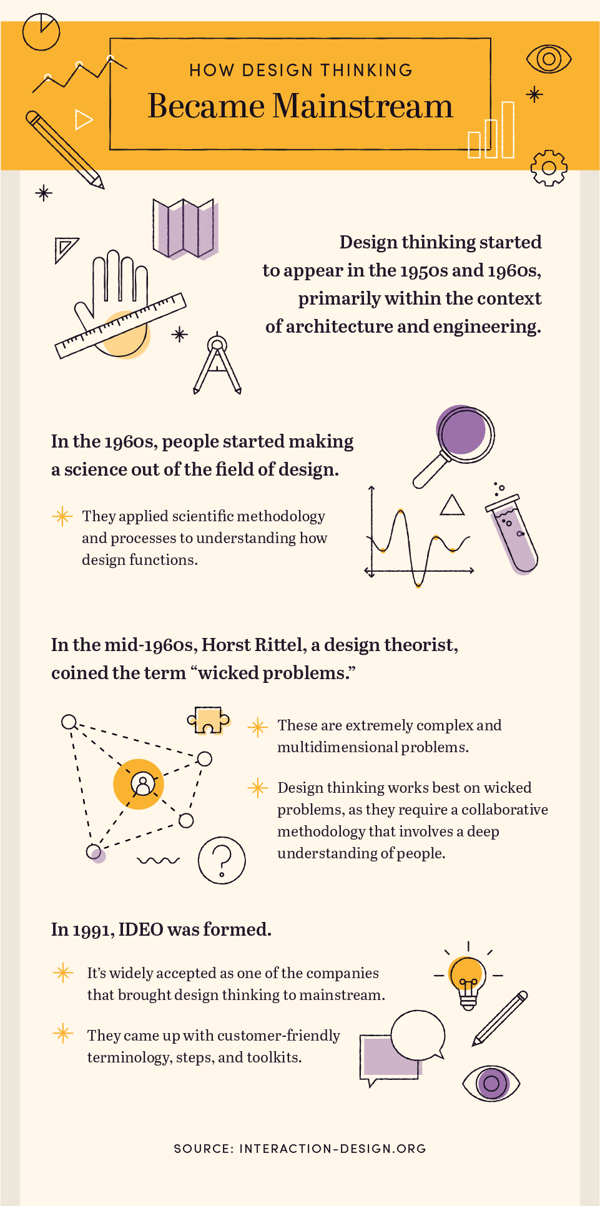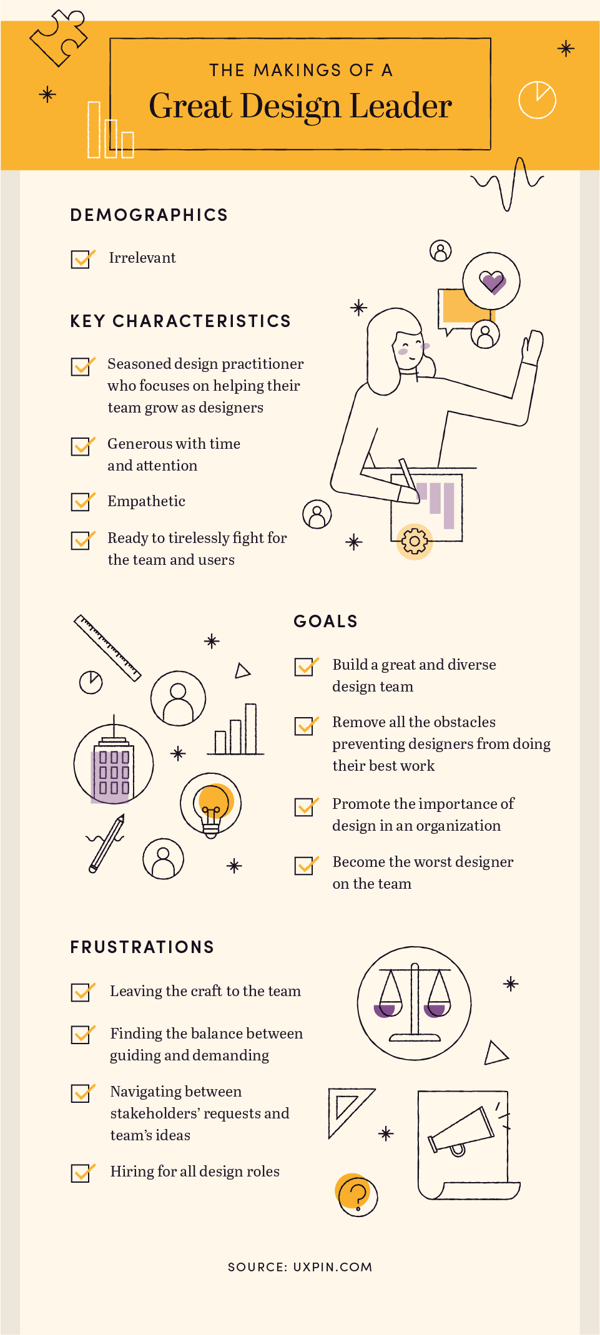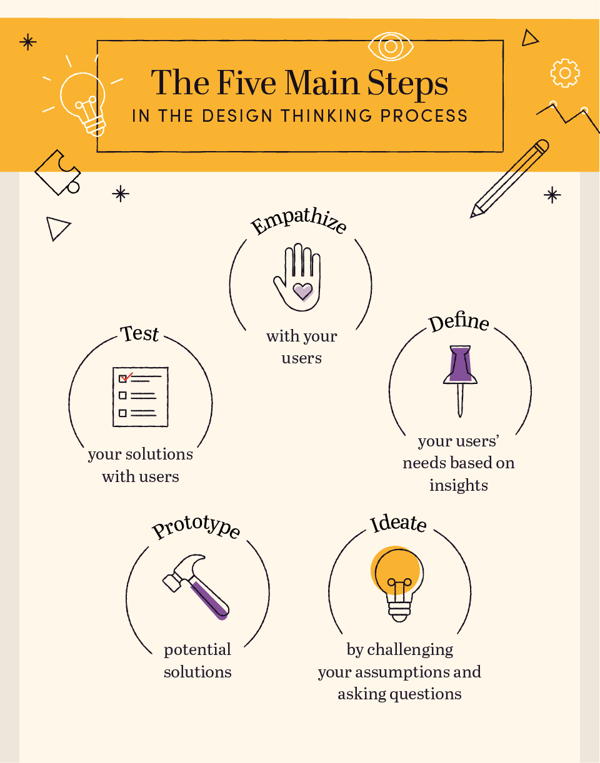Make Design Thinking the Heart of
Your Business Strategy
Throughout the year, teams come up with new strategic initiatives to drive more business, build better products, and go to market faster. Sometimes, particularly during the first quarter, change is embraced as a way to shake up the old and look forward to the many opportunities a fresh year can bring.
This may be a time to take a new approach and join companies like PepsiCo in embracing design thinking. This strategy could be the change your company needs to surpass your past business goals and set your organization up for unprecedented success for years to come.

Design thinking is not a new concept, having evolved over the years after first being introduced to the business world by David M. Kelley, founder of IDEO, in 1991. Kelley, who also founded Stanford University’s Hasso Plattner Institute of Design, is Stanford’s Donald W. Whittier Professor in Mechanical Engineering. He took the process designers use to understand human needs as the foundation for cultivating innovative ideas that don’t just solve problems, but also provide measurable value.
You can find design thinking breaching the corporate world with the hiring of design leaders and companies taking on a design-centric approach to how they build products and services. Many of the companies that have embraced design thinking have done so with great success, often becoming disruptors in their industry. Such companies include Uber and Airbnb, both of which had to use empathy, a key tenet of design thinking, to figure out how to foster trust with their users. After all, their users were getting into strangers’ cars and staying in homes that weren’t their own; with the help of design thinking, these ideas transformed from unheard of to innovative.
Additional examples of companies using design thinking include IBM, McKinsey & Co., PepsiCo, and others. With its 1,600 designers, IBM claims the largest design team in the world. McKinsey & Co. invested in design with its purchase of Lunar, a design firm. PepsiCo’s CEO, Indra Nooyi, hired the company’s first chief design officer. Nooyi says that design “has a voice in nearly every important decision that the company makes.”
Other organizations embrace design thinking, too. For example, Children’s Health System of Texas “identified the need for a new strategy” that helped make the community a greater part of the medical system. This inspired them to create a “wellness ecosystem whose boundaries (and resources) would stretch far beyond the medical center.”
The design thinking process is useful for organizations large and small to manage complex challenges. But why does it work so well?
Developing a Business Strategy: The Traditional Process Versus the Design Thinking Process
The standard process for developing a business strategy starts with a metric or a specific key performance indicator (KPI) to improve. Design thinking, on the other hand, starts by looking at the users or customers and their needs, and then decides from there what metrics will be impacted by solving for that need.
When you start with a metric and decide that improving that metric is your goal, it can be difficult to trace back and find the problem you need to solve for. The value is then a secondary thought, even though value is why a user buys a product or service. This is the challenge with the standard process. Setting a goal is important to developing a business strategy, but that goal should be the value you want to provide to your user. The value, therefore, is your primary focus.
Design thinking starts at the beginning, with the user who buys your product or your service. From there it is easier to discover their pain points, which then may help explain such issues as why a user decides to buy a less-expensive product or switch services. Once you understand the problem, the metrics are derived from the solution you build.

The 5-Step Design Thinking Process
Over the years many firms have taken the process Kelley created and modified it to work within their own organizations. You’ll find that many of these versions have been either simplified or extended, but at the heart of them all, you’ll find the following concepts and steps remain true.
Step 1: Empathize with your users.
The best way to understand your user is to get out there and meet them. Learn more about their motivations and habits. Who they are, where they work, are they always on the go, or do they work a nine-to-five job sitting in front of a computer: These are just a few of the data points that will help you understand your customers better.
Taking the time to build empathy for your users and understand their perspectives will give you key insights into the problems you should be solving for and the value they are seeking.
Step 2: Define your users’ needs and problems based on insights.
After gathering information and insights by interviewing and observing your users, work with your team to synthesize this information and build patterns or groups. By grouping like information, you’ll be able to identify areas of opportunity you should solve for or further investigate.
Step 3: Ideate by challenging your assumptions and asking questions.
If you haven’t already started to brainstorm ways to solve problems for your users, this would be the time to do so. Bring in a variety of team members who can offer different perspectives and throw a bunch of ideas on a wall — literally. Use a markerboard, sticky notes, or another method to visually discuss ideas. Studies have shown that a combination of writing and drawing is ideal for developing creative solutions to problems, so encourage team members to draw ideas out.
There are a few reasons this method works. First, it is often difficult to describe ideas just using words, particularly if you need to describe spatial relationships. Another reason is because a large portion of the brain is used for visual processing; drawings increase the engagement of these regions in the brain during the ideation process.
Finally, discuss all of the ideas as a group. Challenge each one, build on them, and then go another round. The more ideas generated in this stage, the better.
Step 4: Prototype potential solutions.
Once you’ve ideated and landed on some concepts you think could solve your user’s problems, it’s time to mock them up and flesh them out. It’s important to thoroughly think through your solution and make sure you’ve uncovered any holes or hiccups that need further discussion and ideation.
If you work with a development team, this would be a good time to consider how you would build your solution, including what technologies you could leverage.
Step 5: Test your solutions with your users.
Once a prototype has been created, whether it’s a rough sketch on a paper or an inexpensive mock-up, it’s time to put it in front of your users.
It’s important to get feedback early and often — before time and money are spent to build your solution. Testing your potential solutions with your users is a good way to determine if your ideas are on the right track, and a beneficial way to find easy improvements before investing.

Adopting the Design Thinking Process
Adopting design thinking as the heart of your process starts with making your customers, or your users, the main focus. Practicing a user-centered approach helps establish the why behind your business strategy.
Establishing the why is a good way to get individuals on board with your strategies and initiatives. It helps provide clarity to your leaders and employees that empowers them to work toward achieving your business goals.
Of course, adopting the design thinking process isn’t just a leader’s job: It’s the job of the whole company. Design thinking fosters a collaborative work environment that empowers individuals to share their ideas and be innovative.
Instead of just giving orders from the top, it provides the opportunity for employees at all levels and in all functions to be included in your discussions and share their own learnings about users. One way to leverage understanding of your users and gain insights on new areas of opportunities is from the employees closest to them.
The Strategy of Getting to Value
Once you’ve gone through the design thinking process a few times and have had multiple meetings to understand the why, ideate on the what, and discuss the how, you may find that you have discovered many areas of opportunity. For most companies, trying to solve multiple problems at once might not be possible because you don’t have enough resources or time. So, then, how do you decide what to go after first?
Prioritizing Ideas (Why)
Synthesizing learnings and insights early on will help you see areas that have a greater need — one most of your users share. It’s important to make note that if multiple users expressed the same problem in one area, but in another only one or two did, it may not be worth going after those lesser problems at this time.
Don’t toss those problems aside just yet, however. It’s important to look at some other aspects before making your final decision.
Validating Your Ideas (What)
Once you come up with some concepts you’d like to test, it's important to validate that your ideas would be something your users would pay for. While testing, you can try different methods to determine if a user would adopt your product or service.
If your testing determines that your concept would be something the user would pay for — and possibly how much they would pay — that can help you gauge the potential profit that can be made before investing in development.
Building Your Ideas (How)
Another factor to consider with your concept is how much effort would be involved in developing your solution. Effort, cost, and feasibility are three important factors in this decision.
Explore different concepts that solve that same problem. There might be a simpler solution that can be easier and cheaper to build.
Making the Decision
Ultimately, your decision regarding which concept to solve for first will involve understanding and evaluating these three aspects. Discussing the why, what, and how with your team is a quick and effective method to move forward and define your strategy.
Once you determine the solution you are going to build, defining the value and deciding on the metrics that correlate to that value will give you a business goal you can work to achieve. This decision will help influence your company’s decisions down the road for years to come.
Building your design thinking muscle may take time and practice. Start by creating a diverse team. They can refine this process in a way that makes it easier for your company to adopt both design thinking and the solutions it helps create.
Don’t be afraid to refine the process or simplify it to fit your needs. As long as you start with the user, your approach to exploring the problem, collaborating, and testing can be modified into making design thinking the heart of your business strategy.
Want to learn more about design thinking?